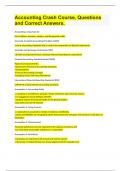Exam (elaborations)
Accounting Crash Course, Questions and Correct Answers.
- Course
- Institution
Accounting Crash Course, Questions and Correct Answers. Accounting is important for firm's officers, investors, lenders, and the general public Generally Accepted Accounting Principles (GAAP) a set of accounting standards that is used in the preparation of financial statements Securities and...
[Show more]



